Year 11 Exam > Year 11 Notes > Biology for GCSE/IGCSE > Sexual Reproduction in Plants
Sexual Reproduction in Plants | Biology for GCSE/IGCSE - Year 11 PDF Download
| Table of contents |

|
| Insect-Pollinated Flowers |

|
| Pollination & Fertilization |

|
| Factors Affecting Seed Germination |

|
| Self- & Cross-Pollination |

|
Insect-Pollinated Flowers
- Flowers are the reproductive structures of plants.
- Most flowers contain both male (stamen) and female (pistil) reproductive parts.
- Plants produce pollen grains which house the male gamete necessary for fertilization.
- Unlike human sperm, pollen lacks the ability to move independently.
- To facilitate reproduction, plants rely on pollination, which can be achieved through insect or wind transfer.
- Insect-pollinated flowers and wind-pollinated flowers each have specialized structures to suit their respective pollination methods.
Parts of the flower
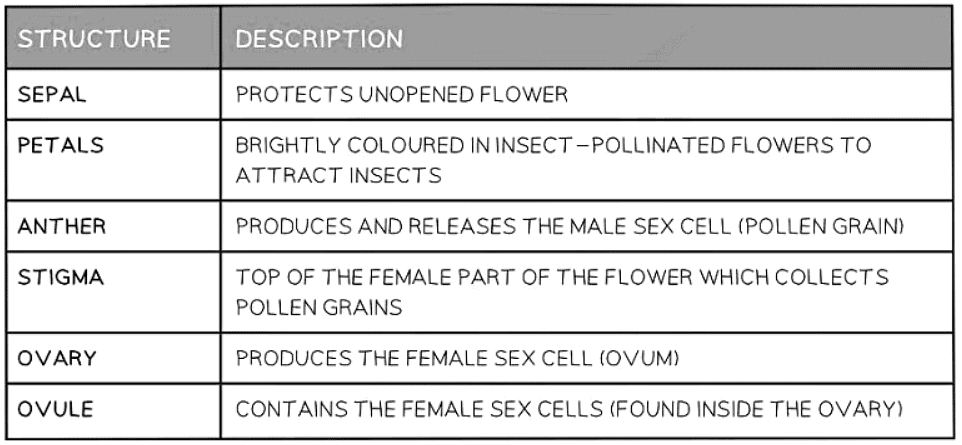
General flower structure

Features of an insect-pollinated flower


Comparison of Pollen in Insect and Wind-Pollinated Flowers:
- Insect-pollinated flowers produce fewer but larger and heavier pollen grains with specialized structures to stick to insects.
- Conversely, wind-pollinated flowers produce large quantities of small, lightweight pollen grains that are usually smooth.
- Comparison of Pollen Grains in Insect and Wind Pollinated Flowers:
- Insect Pollinated Flowers:
- Produce smaller amounts of larger, heavier pollen grains with spikes or hooks for better adhesion to insects.
- Wind Pollinated Flowers:
- Produce large amounts of small, lightweight pollen grains that are typically smooth.
- Insect Pollinated Flowers:
- Here is an example of a multiple-choice question that challenges students to identify different types of pollen grains:
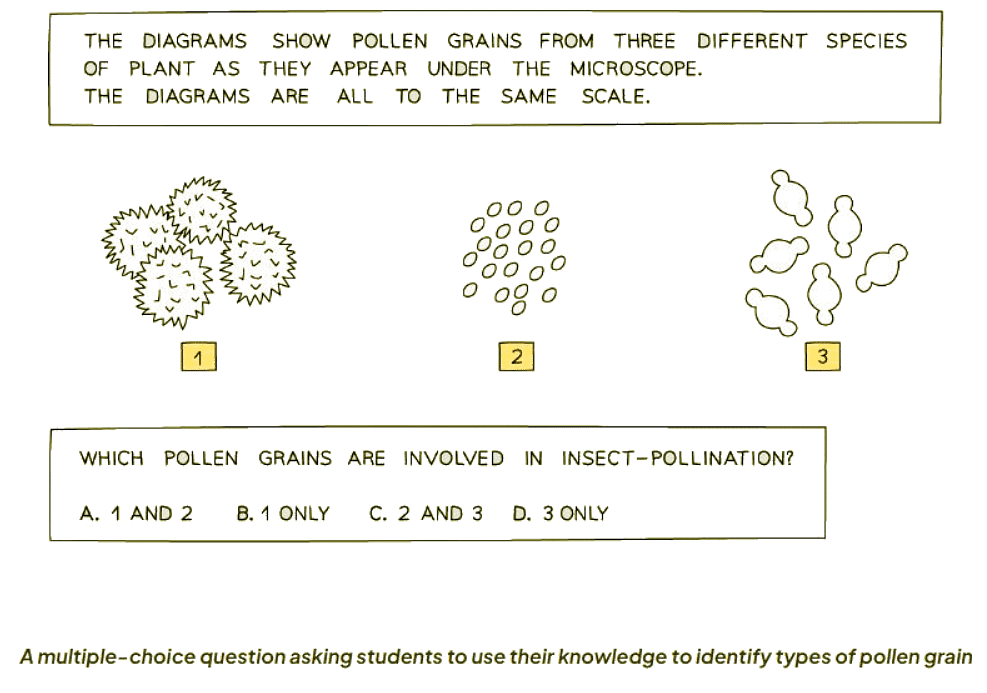
Pollination & Fertilization
Pollination
- Pollination refers to the transfer of pollen grains from the anther to the stigma of a flower.
Fertilisation
- Fertilization takes place when a pollen nucleus combines with an ovum nucleus in the ovule.
- Pollen grains, lacking motility structures, grow a pollen tube to reach the female nucleus in the ovary after landing on a compatible stigma of the same species.
- The pollen nucleus moves down the pollen tube towards the ovary's female ovule nucleus for fusion.
- Ovaries contain ovules, each housing an ovum with a female nucleus receptive to fusion with a male pollen nucleus.
- Successful fusion of nuclei in the ovule results in fertilization and the formation of a zygote, which matures into a seed within the ovule.
- The number of seeds in fruits varies based on the number of ovules present in the plant species, explaining the diversity in seed counts across different fruits.
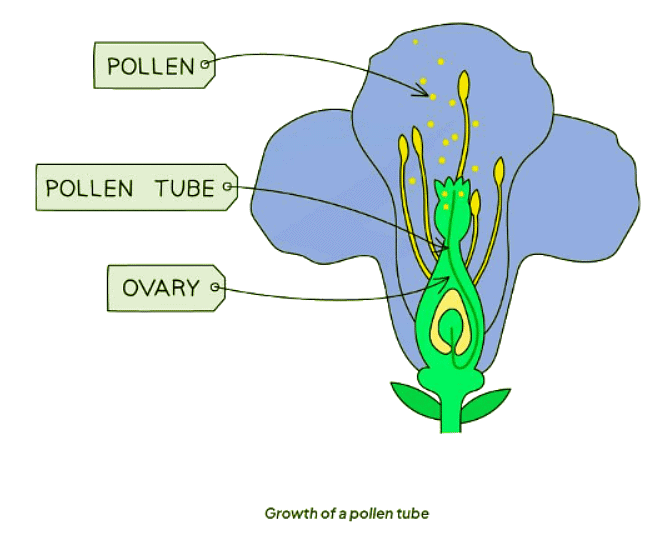

Factors Affecting Seed Germination
- Germination: The Commencement of Seed Growth
- Important Factors for Successful Germination:
- Water: When seeds absorb water, they swell, activating enzymes that trigger growth. For instance, soaked beans show visible enlargement as they prepare to sprout.
- Oxygen: Just like we need oxygen to breathe, seeds need it to release energy for growth. Think of it as their breath of life.
- Warmth: Imagine seeds as tiny factories; warmth acts as the 'on' switch, ensuring that reactions within the seed happen at the right pace for growth. An example is how a warm, sunny day prompts seeds to sprout more rapidly.
Investigating Germination
- Carbon dioxide is not essential for germination, but its presence or absence does not affect the process.
- Conducting Germination Experiments:
- Prepare four boiling tubes, each containing 10 cress seeds placed on cotton wool.
- Arrange the test tubes according to the diagram provided.
- Incubate tubes A, B, and C at 20°C, while tube D is placed in a fridge at 4°C.
- Observe and compare the germination results to identify the tube with the highest number of sprouted seeds.

Conditions required for germination - results:

Self- & Cross-Pollination
- Cross-pollination is a process where pollen from one plant is moved to the stigma of another plant of the same species. This method is widely used by plants to enhance genetic diversity.
- Unlike self-pollination, where pollen can land on the same flower's stigma or another flower on the same plant, cross-pollination fosters genetic variation.
- Self-pollination, resulting in genetically identical offspring, limits genetic diversity, which can be a disadvantage when environmental conditions shift. Offspring may lack adaptive traits.
- In contrast, cross-pollination heavily relies on pollinators. A decline in pollinator populations, such as bees, can pose significant challenges, particularly for crops that depend on them for pollination.
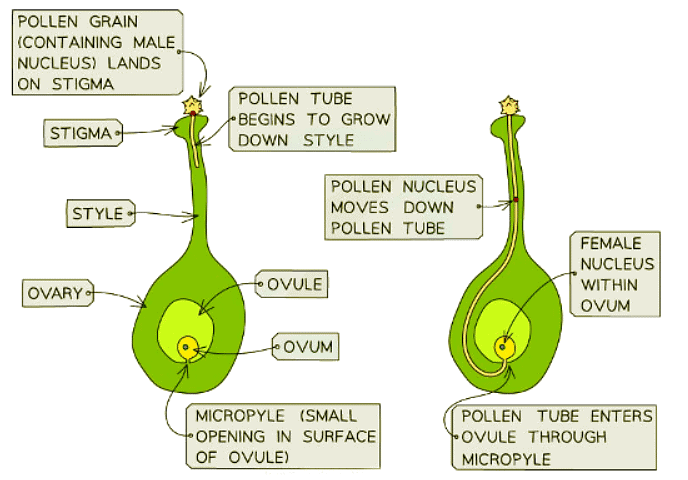
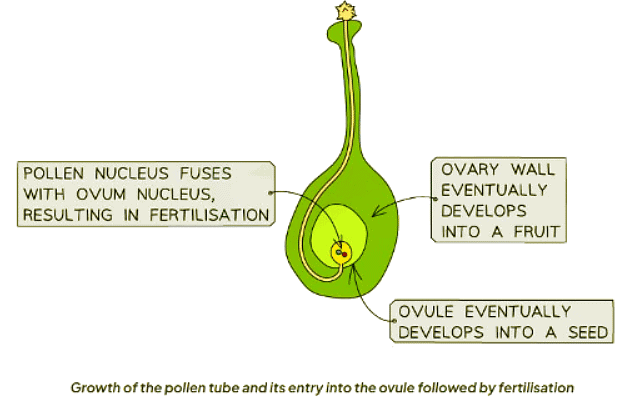
Question for Sexual Reproduction in PlantsTry yourself: What is the purpose of pollination in plants?View Solution
The document Sexual Reproduction in Plants | Biology for GCSE/IGCSE - Year 11 is a part of the Year 11 Course Biology for GCSE/IGCSE.
All you need of Year 11 at this link: Year 11
|
110 videos|158 docs|34 tests
|
FAQs on Sexual Reproduction in Plants - Biology for GCSE/IGCSE - Year 11
| 1. How does pollination occur in insect-pollinated flowers? |  |
Ans. Insect-pollinated flowers attract insects through nectar and fragrance. When an insect lands on the flower to collect nectar, it inadvertently picks up pollen from the flower's stamen and transfers it to the stigma of another flower, leading to pollination.
| 2. What is the role of fertilization in the process of pollination in flowers? |  |
Ans. Fertilization is the fusion of the male gamete (pollen) with the female gamete (ovule) to form a zygote, which eventually develops into a seed. Fertilization occurs after successful pollination and is essential for the production of seeds.
| 3. How do factors such as temperature and moisture affect seed germination? |  |
Ans. Factors like temperature and moisture play a crucial role in seed germination. Optimal temperature and moisture levels are required to activate enzymes that break down stored nutrients in the seed and initiate the growth of the embryo.
| 4. What is the difference between self-pollination and cross-pollination in plants? |  |
Ans. Self-pollination occurs when pollen from the same plant fertilizes the stigma of the same flower or a different flower on the same plant. Cross-pollination, on the other hand, involves the transfer of pollen from one plant to the stigma of another plant of the same species.
| 5. How does sexual reproduction occur in plants through the process of pollination and fertilization? |  |
Ans. Sexual reproduction in plants involves the fusion of male and female gametes through the process of pollination and fertilization. Pollination transfers pollen from the male reproductive structure to the female reproductive structure, leading to fertilization and the formation of seeds.

|
Explore Courses for Year 11 exam
|

|
Signup for Free!
Signup to see your scores go up within 7 days! Learn & Practice with 1000+ FREE Notes, Videos & Tests.
Related Searches
















